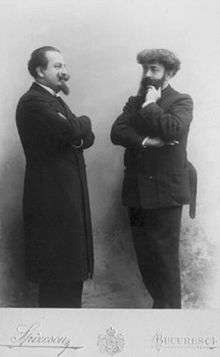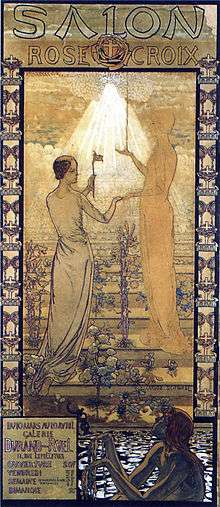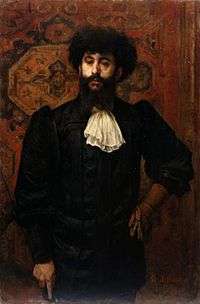Joséphin Péladan


Joséphin Péladan (28 March 1858 in Lyon – 27 June 1918 in Neuilly-sur-Seine) was a French novelist and Martinist. His father was a journalist who had written on prophecies, and professed a philosophic-occult Catholicism. He established the Salon de la Rose + Croix for painters, writers, and musicians sharing his artistic ideals, the Symbolists in particular.
Biography
Péladan was born into a Lyon family that was devoutly Roman Catholic. He studied at Jesuit colleges at Avignon and Nîmes. After he failed his baccalaureat, Péladan moved to Paris and became a literary and art critic.[1] His eldest brother Adrien studied alchemy and occultism as well.
Career
In 1882[2] he came to Paris where Arsene Houssaye gave him a job on his artistic review, L'Artiste. In 1884 he published his first novel, Le vice suprême,[2] which recommended the salvation of man through occult magic of the ancient East.[3] His novel was an instant success with the French public, which was experiencing a revived interest in spirituality and mysticism. The novel went through several printings.[1]
He claimed that a Babylonian King left the title of "Sâr" to his family. Péladan's Le vice suprême was interwoven with Rosicrucian and occult themes. After reading Péladan's novel, the French poet Stanislas de Guaita became interested in occultism. In Paris, De Guaita and Péladan became acquainted, and in 1884, the two decided to try to rebuild the medieval secret society, the Rosicrucian Brotherhood. Péladan was influenced by the teachings of Eliphas Lévi.[1]
De Guaita and Péladan recruited Gérard Encausse to help rebuild the brotherhood. Encausse, who went by the pseudonym “Papus”, was a Spanish-born French physician and occultist who had written books on magic, Kabbalah and the Tarot. In 1888, De Guaita founded the Cabalistic Order of the Rosicrucian. The Rosicrucian Order is a legendary and secretive Order that was first publicly documented in the early 17th century.
Guaita's Rosicrucian Order provided training in the Kabbalah, an esoteric form of Jewish mysticism, which attempts to reveal hidden mystical insights in the Hebrew Bible and divine nature. The order also conducted examinations and provided university degrees on Kabbalah topics. De Guaita had a large private library of books on metaphysical issues, magic, and the "hidden sciences." He was nicknamed the "Prince of the Rosicrucians" by his contemporaries for his broad learning on Rosicrucian issues.
By the 1890s, De Guaita's, Papus' and Péladan’s collaboration became increasingly strained by disagreements over strategy and doctrines. De Guaita and Papus lost the support of Péladan, who left to start a competing order. In June 1890, Péladan left the Martinist Order and created a quasi-Catholic Mystic Order of the Rose + Cross. Péladan was the leader of the new order, and he took the titles of "Imperator" and "Super Magician".
Mystic Order of the Rose + Cross and the Salon de la Rose + Croix
The Mystic Order of the Rose + Cross inspired Péladan to organise an outlet for his beliefs concerning the role of spirituality and idealism in art. As an art critic, Péladan had been vocal in critiquing the dominant trends in French art, which included officially sanctioned styles promoted by the academy, and the Impressionists. This resulted in a series of six exhibits of Symbolist artists and associated French avant-garde painters, writers, and musicians, as the Salon de la Rose + Croix. The Salon was enormously popular with the press and public, but failed to succeed in revolutionising French art, as Péladan had hoped.[1]
Publications

Marcellin Desboutin (1891)
- Le Vice suprême, novel, 1884
- Curieuse, 1885
- Femmes honnêtes!, 1885
- L'Initiation sentimentale, 1887
- Istar, 1888
- A coeur perdu, 1888
- Coeur en peine, 1890
- Le prochain conclave; instructions aux cardinaux, 1890
- Comment on devient mage, 1891
- L'androgyne, 1891
- La gynandre, 1891
- La Typhonia, 1892
- Le panthée, 1892
- La queste du Graal - proses lyriques de l'éthopée - la décadence latine; published "au salon de la Rose+Croix" (1892)
- Le théâtre complet de Wagner: les XI opéras scène par scène avec notes biographiques et critiques, 1894
- L'art idéaliste et mystique: doctrine de l'ordre et du salon annuel des Rose + Croix , 1894
- Babylone, tragedy, 1895
- Mélusine, 1895
- Le dernier Bourbon, tragedy, 1895
- Le livre du sceptre: politics, 1895
- La Prométhéide : trilogie d'Eschyle en quatre tableaux, 1895
- Le Prince de Byzance, tragedy, 1896
- Œdipe et le Sphinx, tragedy in prose, 1903
- Sémiramis, tragédie en prose, 1904
- La Dernière Leçon de Léonard de Vinci, essay, 1904
- La Clé de Rabelais, 1905
- De Parsifal à don Quichotte, essay, 1906
- La Doctrine de Dante, 1908
- La philosophie de Léonard de Vinci d'après ses manuscrits, essay, 1910 (rééd. Stalker, 2007)
- De l'Androgyne. Théorie plastique, essay 1910
See also
References
- 1 2 3 4 Greer, John MIchael (2003). The new encyclopedia of the occult. Llewellyn Worldwide. p. 365. ISBN 9781567183368.
- 1 2 Lucie-Smith, Edward. (1972) Symbolist Art. London: Thames & Hudson, p. 109. ISBN 0500201250
- ↑ Rudorff, Raymond, The Belle Epoque - Paris in the Nineties, Saturday Review Press, New York, 1972. (pp. 185-195).